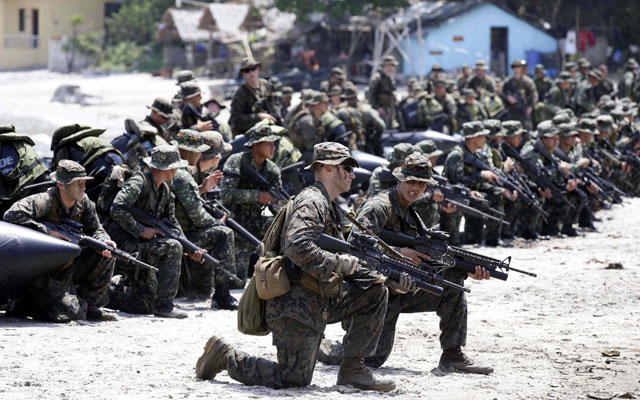The armed forces of the United States and the Philippines conducted the 29th annual Balikatan joint military exercises April 5 through April 17. These military exercises are the largest and most significant joint military operations between the U.S. and Filipino militaries.
The exercises are “a signature element” of the “two nations’ robust treaty alliance relationship.” The war games help the U.S. military and Filipino military operate more effectively together—especially when it comes to humanitarian disaster relief missions.
But the militaries also conduct joint field exercises and try to come up with more effective ways to work together on the battlefield amid the chaos of combat. More than 8,000 U.S. and Filipino troops took part in the exercises. The U.S. Marine Corps brought in heavy-hitting military hardware—F/A-18 fighters, MV-22 Osprey aircraft, and amphibious assault vehicles (AAVs)—to make the field exercises as realistic as possible.
One of the major challenges for the U.S. in the region is the weakness of Filipino naval and air forces. As one member of the Academy of Military Sciences of the Chinese People’s Liberation Army commented, “In this joint exercise, the U.S. side mobilized a large amount of advanced navy and air force equipment, while the Philippines had but little to show in contrast.” The U.S. therefore acts as a “bodyguard” for the Philippines.
It’s not quite that simple. These exercises build on the interoperability of U.S. and Filipino forces. Such cooperation also sets an example for military-to-military cooperation with other countries in the region at a time when U.S. leadership is critical. The territorial disputes in the South China Sea, particularly between the Philippines and China, demand that the U.S. take a strong stance to guarantee the security of our treaty allies and to maintain the freedom of navigation in the South China Sea.
The U.S.–Philippines alliance needs a better equipped, more “ready” Filipino element. As Filipino scholar Renato de Castro and Heritage’s Walter Lohman explain:
The Philippines has the weakest navy in the region, and its air force is unable to patrol and monitor its vast maritime territory. It resorts to the futile filing of diplomatic protests whenever an aggressive China encroaches on its [exclusive economic zone].
The symbol of the Philippines’s need for assistance is the fact that it does not have a single fighter aircraft in service today.
In light of the current situation, the U.S. should:
- Help the Filipino military build up its forces, particularly its naval and air forces, so that they can contribute more to the alliance;
- Reaffirm our commitment to the 1951 U.S–Philippines Mutual Defense Treaty (MDF) and make it clear that an attack on either U.S. or Filipino “armed forces, public vessels or aircraft in the Pacific” will result in a U.S. response in accordance with the MDF treaty; and
- Maintain a strong forward-deployed presence in the Western Pacific. As Lohman argues, a strong America in Asia will lead to a “stable and secure” region and will lend credibility to our commitment to our allies.
Maintaining a strong relationship with the Philippines and helping them build up their military forces is an absolutely critical factor in the U.S. strategic “pivot” to Asia.
Andy Thomchick is currently a member of the Young Leaders Program at The Heritage Foundation. For more information on interning at Heritage, please click here.





























